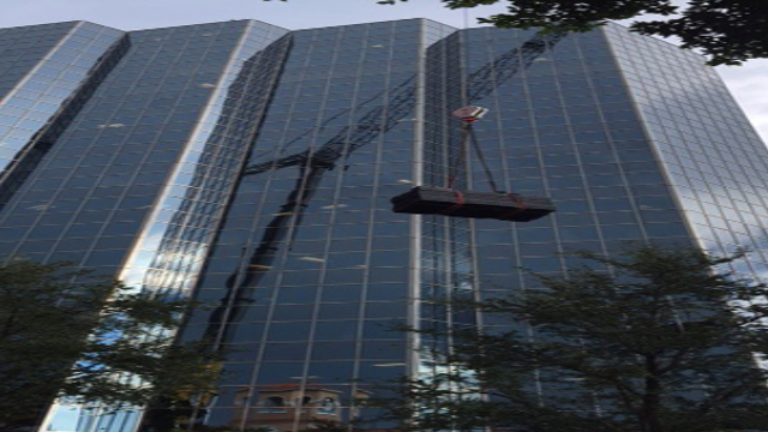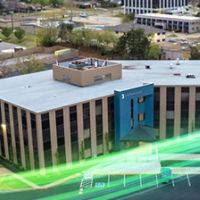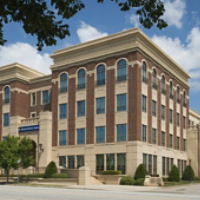Customer Story
One Clearlake Centre
One Clearlake Centre is an 18-story, Class-A commercial office building housing tenants in a variety of industries including financial and legal services, office staffing and insurance. The LEED Silver Certified building is owned by AEW Capital Management, LP and managed by CBRE, Inc., the world’s largest commercial real estate services and investment firm. Committed to sustainability, CBRE was the first company in its industry to achieve carbon neutrality in its operations.

Quick Facts
- Industry
- Commercial Real Estate
- Products
- Comprehensive Chilled Water Systems • myPLV Design Tool • CenTraVac Chillers • Tracer SC+
- Topics
- Sustainability • Energy Efficiency • Optimal Comfort • Cost-Saving
- Services
- Upgrading

The Challenge
Although the nearly 30 year old Trane chillers serving One Clearlake Centre had few issues, AEW Capital Management, LP and CBRE foresaw that the aging machines might soon require increased maintenance, and created a potential risk for failure. CBRE sought to upgrade the chiller plant to improve reliability and efficiency, and to more economically accommodate its tenants' extended hours. In alignment with its corporate sustainability commitment, CBRE also wished to reduce the building’s environmental impact.
The Solution
Consulting with Killingsworth Engineering and Trane, CBRE outlined objectives for a more modern, efficient and flexible chiller plant. Before moving forward, a complete assessment was made of the building’s mechanical systems. Although the cooling towers were in good condition, the PVC fill material in them had deteriorated. The original equipment condenser and chilled water pumps needed to be replaced. In addition, the Trane building automation system was working well, but lacked features of newer systems. CBRE sought to take advantage of new technologies, as well as adhere to revised building codes.
Evaluating chiller options
With the objective to replace the existing equipment with high efficiency chillers capable of operating during after-hours low load scenarios, Trane and CBRE used the Trane myPLV™ chiller performance analysis tool to compare and contrast various chiller offerings. The tool uses location, building type, and chiller plant design to calculate a unique myPLV efficiency value. Because it considers individual criteria rather than averages, myPLV is able to accurately predict future chiller performance. Using the myPLV results, it was determined that a 300-ton Trane® Series S™ CenTraVac™ chiller provided best in class efficiency with the desired low load capabilities. Although other chillers offered lower first costs, the myPLV bid form showed the energy savings that would be realized with the Series S chiller, making it the most favorable option amongst the six chillers being considered.
Improving energy efficiency, reliability and comfort
With advanced technologies, such as mixed-flow impellers and AdaptiSpeed™ control, the oil-free Trane® Series S™ CenTraVac™ chillers provide reliable operation, and are ideal for part-load applications. The quiet operation of the centrifugal compressors, typically less than 70 dBA, helps ensure a pleasant work environment for tenants. To improve system performance, the deteriorating cooling tower fill was replaced, and new pumps with high efficiency motors were installed. Variable speed drives were added to the chilled water pumps to ensure that only the needed amount of chilled water is circulated.
Upgrading technology
Building controls were upgraded to a Tracer™ SC building automation system (BAS) providing operators convenient, remote access to building systems via any Web-enabled device. Built upon an open protocol platform for integration flexibility, Tracer SC communicates with LON or BACnet unit controllers, which allowed the existing LON variable air volume (VAV) controllers to remain in place and be integrated into the new system, minimizing disruption to tenants and reducing overall project cost. The existing chiller plant control points were programmed into a new Trane UC800 controller and the plant was configured using the Tracer SC Chiller Plant Control (CPC) application. CPC combines Trane’s knowledge and chiller plant expertise into a standard application to optimize performance, generate energy savings, reduce maintenance costs, and extend equipment life. The air handling units were retrofitted with new BACnet controllers, CO2 sensors, and outside air dampers with flow measuring devices, and a demand control ventilation strategy was implemented.
The Results
Equipment and controls upgrades, implemented by Trane and CBRE at One Clearlake Centre, are achieving the building manager's goals to improve comfort, indoor air quality and energy efficiency, while reducing operational costs. The upgrades are expected to save nearly $66,000 a year. “In June, our energy use dropped 15 percent compared to last June," said Michelle Horn, Senior Real Estate Manager, CBRE. “I worked with Trane to utilize both pumps with one chiller; original program was one chiller, one pump. Historically, the building would require a second chiller based on lack of flow, not tonnage," said Wayne Stracke, Chief Building Engineer, CBRE. "Utilizing both pumps enables the building to operate on one machine longer and in some cases all day. Pumps aren’t required to run at 100 percent."



